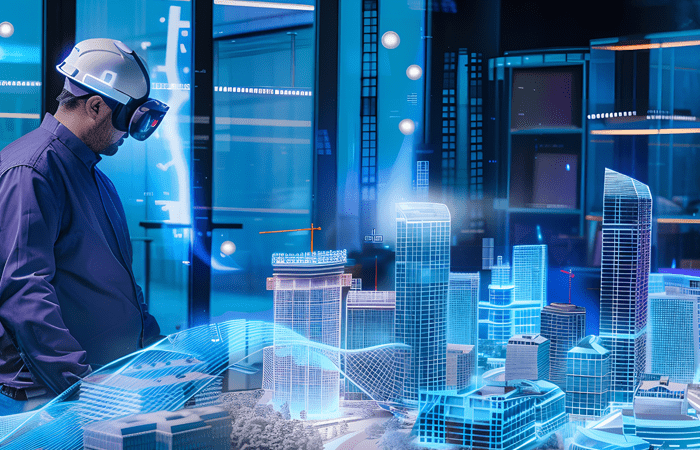
The Future of BIM in Architectural Design: Trends and Innovations for 2024-25
Building Information Modeling (BIM) has revolutionized the architecture, engineering, and construction (AEC) industry, offering a more efficient and collaborative approach to project design and execution. As we move into 2024, BIM continues to evolve, bringing forth new trends and innovations that promise to further transform architectural design.
This blog explores the future of BIM in architectural design, highlighting the key trends and innovations to watch out for in 2024-25.
- Enhanced Collaboration Through Cloud-Based BIM
One of the most significant trends in BIM for 2024 is the increased adoption of cloud-based platforms. Cloud-based BIM solutions enable real-time collaboration among project stakeholders, regardless of their geographical location. This means that architects, engineers, contractors, and clients can access and update project information simultaneously, leading to improved communication, reduced errors, and faster decision-making processes.
For instance, Autodesk’s BIM 360 platform has been at the forefront of this trend, offering a suite of tools that support seamless collaboration. In 2024, we can expect more advanced features, such as enhanced data security, better integration with other cloud services, and improved performance, making cloud-based BIM an indispensable tool for modern architectural practices.
- Integration of Artificial Intelligence and Machine Learning
Artificial Intelligence (AI) and Machine Learning (ML) are poised to play a crucial role in the future of BIM. These technologies can analyze vast amounts of data generated during the design and construction processes, providing valuable insights that can inform decision-making and improve project outcomes.
In architectural design, AI and ML can assist in generating optimized design solutions based on specific project requirements and constraints. For example, AI algorithms can analyze environmental data to suggest sustainable design features, such as optimal building orientation, natural lighting solutions, and energy-efficient materials. Additionally, ML can help predict potential project risks and propose mitigation strategies, enhancing overall project efficiency and safety.
- Integration with Augmented Reality (AR) and Virtual Reality (VR)
The integration of BIM with Augmented Reality (AR) and Virtual Reality (VR) technologies is another exciting trend to watch in 2024. AR and VR can provide immersive experiences that allow architects and clients to visualize and interact with 3D models in a more intuitive and engaging way.
AR can overlay digital information onto the physical environment, enabling architects to conduct on-site inspections and assessments with greater accuracy. VR, on the other hand, offers a fully immersive experience, allowing stakeholders to “walk through” a virtual representation of the building before construction begins. This not only aids in identifying design issues early but also helps clients better understand and approve design concepts.
- Advancements in Generative Design
Generative design is an innovative approach that leverages the power of algorithms to generate multiple design options based on predefined parameters and constraints. This trend is set to gain momentum in 2024, as more architects recognize the potential of generative design to create complex, efficient, and optimized structures.
Using generative design tools, architects can input specific criteria such as spatial requirements, material preferences, and environmental considerations. The software then generates a range of design solutions, from which the architect can select the most suitable option. This iterative process not only accelerates the design phase but also ensures that the final design is both functional and aesthetically pleasing.
- Increased Focus on Sustainability and Green Building
Sustainability continues to be a driving force in architectural design, and BIM is at the forefront of this movement. In 2024, we can expect BIM tools to incorporate even more advanced features for sustainable design, such as detailed energy analysis, carbon footprint calculations, and lifecycle assessment.
BIM software can simulate the performance of different design alternatives, helping architects choose the most energy-efficient and environmentally friendly options. For example, BIM can analyze the impact of various building materials on energy consumption and indoor air quality, enabling architects to make informed decisions that promote sustainability. Additionally, BIM can facilitate compliance with green building certifications, such as LEED and BREEAM, by providing comprehensive documentation and analysis.
- Enhanced Data Analytics and Reporting
Data analytics and reporting are becoming increasingly important in the AEC industry, and BIM is no exception. In 2024, we can expect BIM tools to offer more advanced data analytics capabilities, allowing architects to gain deeper insights into their projects and make data-driven decisions.
Enhanced data analytics can help architects monitor project performance in real-time, identify potential issues, and implement corrective measures promptly. For example, BIM software can track key performance indicators (KPIs) such as project costs, timelines, and resource utilization, providing architects with a comprehensive overview of project health. Furthermore, advanced reporting features can generate detailed reports and dashboards, making it easier for architects to communicate project status to stakeholders.
- Improved Interoperability with Other Software
Interoperability has always been a challenge in the AEC industry, as different project stakeholders often use various software tools that may not be compatible with one another. However, the future of BIM in 2024 looks promising, with improved interoperability between BIM software and other tools, such as Computer-Aided Design (CAD) software, project management platforms, and facility management systems.
Improved interoperability ensures seamless data exchange between different software applications, reducing the risk of data loss and errors. This integration allows architects to leverage the full potential of BIM by combining it with other tools to enhance project efficiency and collaboration. For example, architects can import CAD drawings into BIM software to create detailed 3D models or export BIM data to project management platforms for better project tracking and coordination.
- Emphasis on BIM for Facility Management
While BIM is traditionally associated with the design and construction phases, its potential for facility management is increasingly being recognized. In 2024, we can expect a greater emphasis on using BIM for the entire lifecycle of a building, including operation and maintenance.
BIM can serve as a valuable tool for facility managers by providing a comprehensive digital representation of the building, complete with detailed information on building systems, equipment, and maintenance schedules. This enables facility managers to efficiently plan and execute maintenance activities, track asset performance, and make informed decisions regarding repairs and upgrades. Additionally, BIM can facilitate the integration of Internet of Things (IoT) devices, allowing for real-time monitoring and control of building systems.
- Adoption of Open BIM Standards
Open BIM standards, such as Industry Foundation Classes (IFC), are gaining traction as the industry moves towards greater collaboration and data sharing. Open BIM standards enable seamless exchange of information between different software applications, promoting interoperability and reducing data silos.
In 2024, we can expect wider adoption of open BIM standards, driven by industry initiatives and regulatory requirements. This will not only improve collaboration among project stakeholders but also ensure that BIM data remains accessible and usable throughout the building’s lifecycle. Architects can benefit from open BIM standards by easily sharing design information with other professionals, such as engineers and contractors, and by ensuring that their BIM models are compatible with different software tools.
- BIM and Modular Construction
Modular construction, which involves prefabricating building components off-site and assembling them on-site, is becoming increasingly popular due to its efficiency and cost-effectiveness. BIM is well-suited for modular construction, as it enables precise design and coordination of prefabricated components.
In 2024, we can expect greater integration of BIM with modular construction processes, leading to faster project delivery and improved quality control. BIM can facilitate the design and fabrication of modular components, ensuring that they fit together seamlessly during assembly. Additionally, BIM can help architects and contractors identify potential clashes and resolve them before construction begins, reducing the risk of delays and rework.
As we look ahead to 2024, the future of BIM in architectural design is filled with exciting possibilities. Enhanced collaboration through cloud-based platforms, the integration of AI and ML, advancements in generative design, and a focus on sustainability are just a few of the trends that will shape the industry. Additionally, improved data analytics, interoperability, and the adoption of open BIM standards will further enhance the efficiency and effectiveness of BIM in architectural design.
Architects who embrace these trends and innovations will be well-positioned to deliver cutting-edge designs that meet the evolving needs of their clients and the industry. The continued evolution of BIM promises to transform architectural design, making it more collaborative, efficient, and sustainable than ever before.

